- by Alison
Pacific dengue outbreak: How Vanuatu Red Cross and IFRC are helping island communities fight back
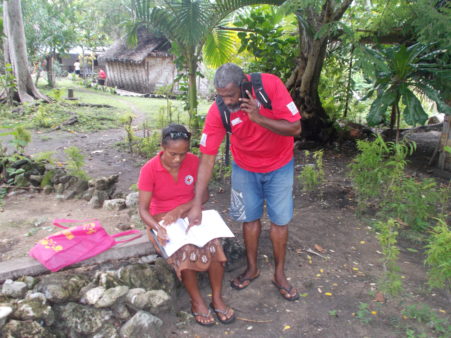
Photo courtesy of Vanuatu Red Cross Society
The Pacific Island nation of Vanuatu is no stranger to dengue; the country has experienced five major dengue outbreaks since 1970. In January this year, local authorities called on the Vanuatu Red Cross Society (VRCS) to help curb what was turning into a very significant new outbreak. The Vanuatu Red Cross Society’s ongoing health education, awareness raising, and community mobilization operations have reached thousands of islanders.
Vanuatu’s rainy season spans November to April. During this six-month period, islanders and tourists alike risk being bitten by the Aedes aegypti mosquito that has made this group of around 80 tropical islands, home. A dengue outbreak had not occurred in Vanuatu since June 2014 – when 300 cases were reported.
At the beginning of the 2016 wet season, on 11th November, Vanuatu recorded its first new case of dengue for more than two years. Within weeks, case numbers began rising rapidly.
As of 1st April, the number of suspected dengue cases reported had reached 2238, including 90 hospitalizations, according to the Vanuatu Ministry of Health. A total of 446 cases have been confirmed, 90 of them severe.
Springing into action to combat dengue in Vanuatu
In December 2016, the local Ministry of Health established a National Dengue Task Force (NDTF) and began an Emergency Rapid Response to tackle the outbreak. Its plans included heightening dengue awareness, reducing breeding sites and distributing educational and communication materials, amongst other things. In January, it called out to the IFRC and Vanuatu Red Cross for assistance.
“The International Federation of Red Cross and Red Crescent Societies (IFRC) provided technical support during the design phase of the dengue Emergency Rapid Response,” says IFRC health worker Angus Walker. “It also released emergency funds of 81,000 Swiss francs to support a three-month operation lasting from January 21st until April 26th.”
Working closely with the Ministry of Health, the Red Cross began by conducting a survey to assess the knowledge, attitudes, and practices of community members in provincial locations. It would use the information gathered, along with other assessment information, to inform its response and help it to plan accordingly.
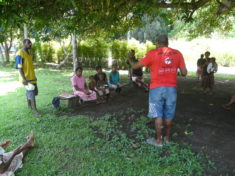
Health Assistant Denny Manvoi conducts a KAP assessment. Photo courtesy of Vanuatu Red Cross Society
“We asked a wide range of questions, including what people would do if a family member displayed dengue symptoms,” says Vanuatu Red Cross health coordinator Sandrine
“We asked a wide range of questions, including what people would do if a family member displayed dengue symptoms,” says Vanuatu Red Cross health coordinator Sandrine Benjimen. “We discovered that people tend to delay treatment or turn to herbal remedies when dengue symptoms are present.”
These behaviors can lead to complications, especially if the dengue progresses to its severe form. Given this, the Red Cross developed key messages aimed at encouraging people to seek medical advice early.
Awareness and education crucial to changing behavior
The Red Cross response is supported by Vanuatu Red Cross volunteers and health team. Thirty-five volunteers are currently active in two provincial locations, mobilizing communities, including schools, and disseminating relevant information.
Sandrine and Red Cross health assistant Denny Manvoi conducted several workshops in dengue hotspots to train volunteers ahead of a dengue awareness and response campaign. Volunteers were given copies of the IFRC ZDC (Zika, dengue, and chikungunya) Prevention Toolkit, which had been adapted to focus on dengue and translated into Vanuatu’s local language – Bislama.
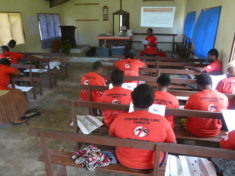
Health Coordinator, Sandrine Benjimen conducts an awareness workshop. Photo courtesy of Angus Walker/IFRC
The three-month dengue campaign began shortly afterward. “We printed 4,000 pamphlets and 200 posters,” says Sandrine. “These explain dengue symptoms and when to get treatment. They also tell people how they can help stop the spread of dengue. Disseminating factual information, along with other activities, is an important part of changing people’s behavior.”
Before initiating the campaign, the Vanuatu Red Cross worked closely with local community leaders and church elders to gain their support, which would be vital for ensuring the campaign had the full backing of the local community.
After all, the awareness campaign is very people oriented, involving door-to-door visits to speak with families and working with schools.
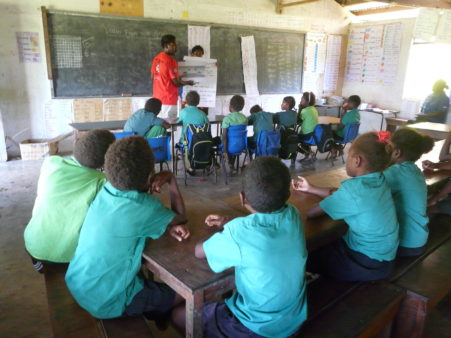
Volunteers working with students to educate them about dengue. Photo courtesy of Angus Walker/IFRC
“We’re working in schools to educate students on dengue, teaching them about the mosquito life cycle, disease transmission, larval habitats, and control measures,” Sandrine says. “The ZDC Toolkit also provides a range of games and activities that help to make the learning fun and interactive.”
Broadening reach
Roads on some of the dengue-infected islands are more than 100 kilometers long and virtually impassable during the rainy season. Needing an effective way to reach remote communities, the Red Cross turned to social media, the local press, radio, and text messaging.
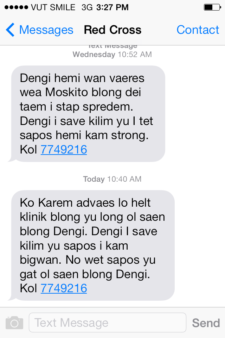
Image via Vanuatu Red Cross Society
“We began our Digicel SMS communication campaign by surveying 250 people in the two provincial hotspots,” says Sandrine. “Then, on 13th March, we initiated a four-week campaign sending SMS messages in Bislama to 8,500 recipients to raise awareness of dengue symptoms, treatment, and prevention.”
To enable two-way communication, some of the messages also included a phone number that people could ring for further advice.
Additional strategies
The ZDC Toolkit also includes another important activity: environmental mapping. Conducted by community members and school students, with the support of Red Cross volunteers, environmental mapping identifies mosquito breeding areas as part of the community mobilization process. Based on this information, communities and students can then develop and implement action plans.
The Red Cross dengue campaign aims to reach 26,000 people, including 1,250 families in two dengue hotspots. It will run until the end of April, despite dengue numbers falling significantly over recent weeks.
“Our strategy is to work with the community to not only curb the current outbreak but also to ensure the community is better equipped to prevent future dengue outbreaks,” says Sandrine. “The end of the wet season can create more mosquito breeding sites because water that is usually flushed by heavy rain can stagnate. It’s important that people don’t become complacent when the rains become less frequent.”
—
Dengue update: Solomon Islands
The nearby Solomon Islands have also been fighting a significant dengue outbreak, which began in October 2016.
As of 5th March, there were more than 11,500 suspected cases of dengue reported, according to the Solomon Islands Ministry of Health and Medical Services. These included 774 hospitalizations and 12 deaths.
Around 28% of reported cases were tested, and 44% of those were confirmed as dengue.
Fortunately, the number of cases is starting to decrease, indicating a possible slowdown in the outbreak.
—
Is there a dengue outbreak in your area? Tell us how awareness, education, and mobilization are helping your community fight this deadly disease.

